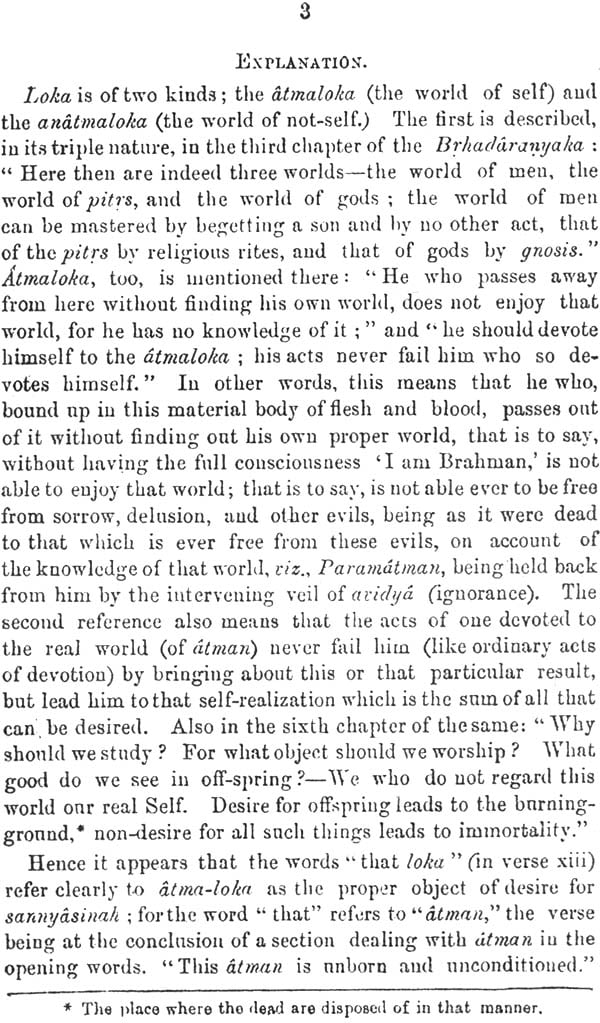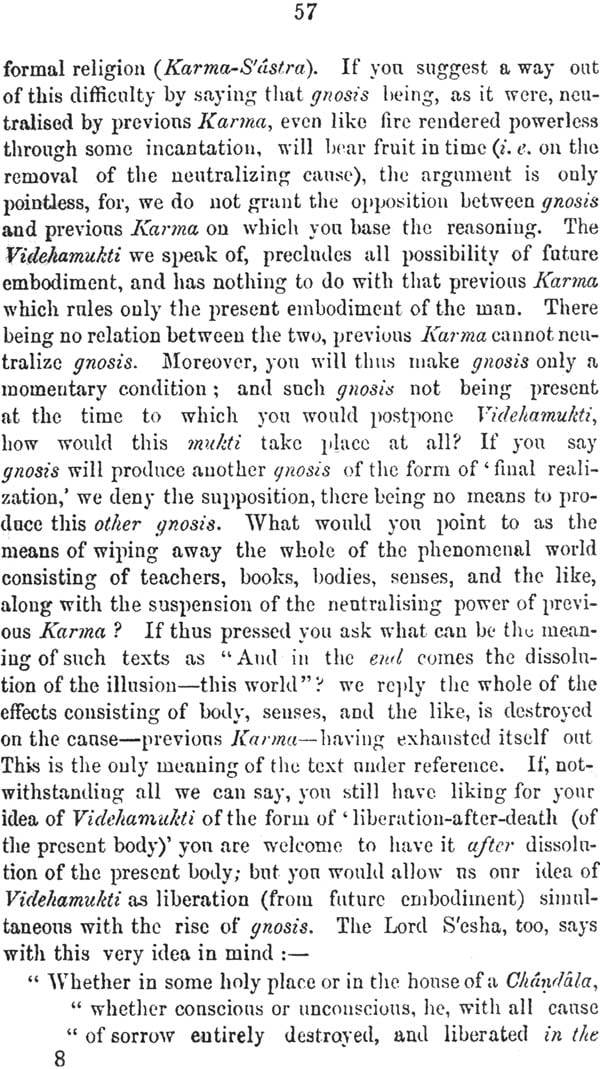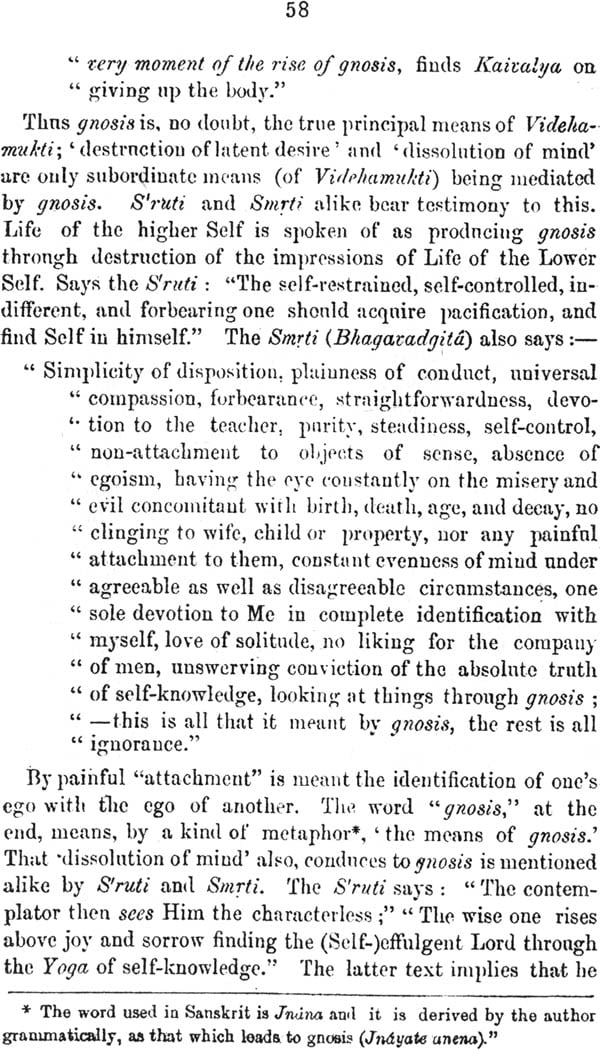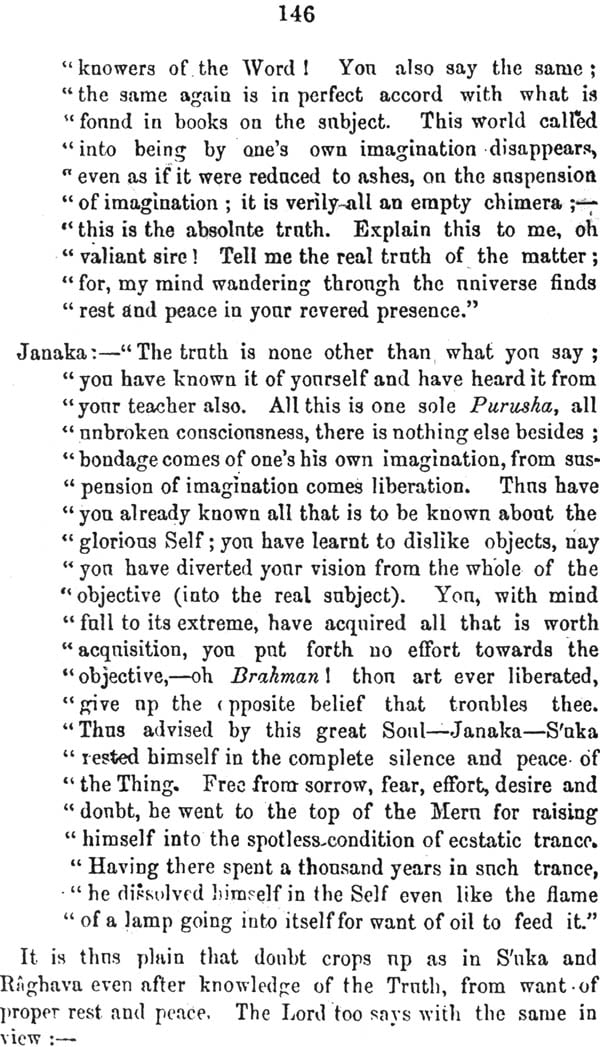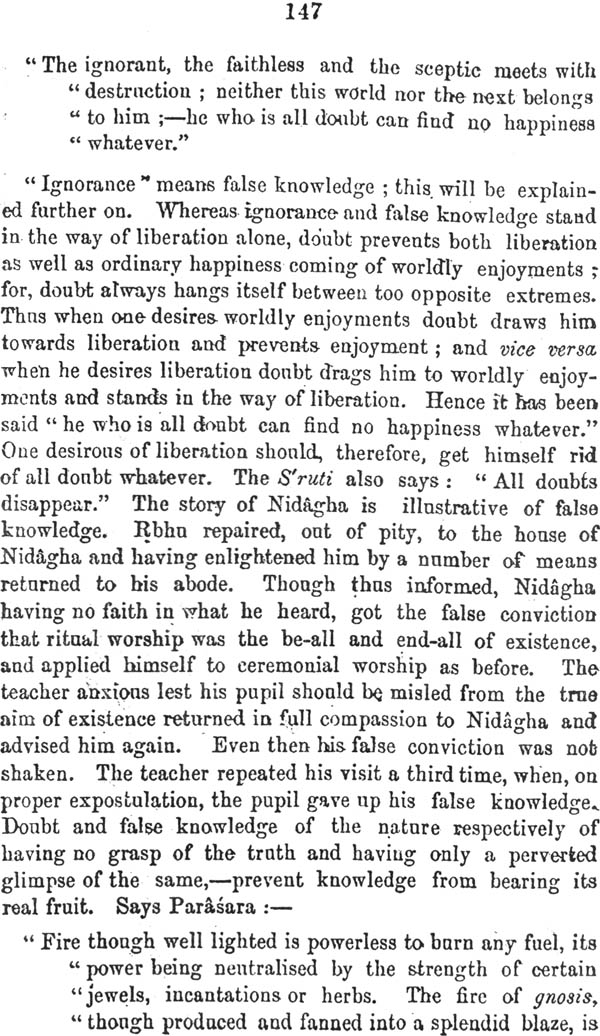
The Jivanmukti-Viveka or The Path to Liberation in This Life
Book Specification
| Item Code: | IHL109 |
| Author: | M.N. Dvivedi |
| Publisher: | Sri Satguru Publications |
| Language: | (English Translation) |
| Edition: | 2008 |
| ISBN: | 8170308844 |
| Pages: | 207 |
| Cover: | Hardcover |
| Other Details | 8.9 Inch X 5.8 Inch |
| Weight | 420 gm |
Book Description
The Jivanmukti- Viveka or the path of liberation in this life is compilation form several important works by the great scholar Vidyaranya. He is known to have written on almost every important branch of written on almost every important branch of literature in his time with such grasp and finish as would surprise the most accurate writer of the present day.
The first chapter opens with a discussion on the nature of Renunciation. The second chapter begins with mention of the means to acquire the condition of Jivanmukti. These are three n numbers Gnosis, Dissolution of mind and Destruction of learn desire. The third path of liberation is dissolution of mind. The third chapter fully deals with this question what is aim or use of Jivanmukti. The fifth chapter concludes the original inquiry into the nature of Renunciation the true path.
The path of liberation by Swami Vidyaranya is a well known book unique in the favor it finds with the Sannyasins of India. My friend Mr. Tookaram Tatya of Bombay who has spared no pains to organize the Theosophic Publication fund requested me to render the work into English and I gladly complied with his request making over the copy right of this first edition to the useful fund he has devoted to the service of Theosophic Literature. I am sure the following pages will be found substantially useful to the earnest student in search of something practical as an aid in the noble line of his inquiry.
The Jivanmukti- Viveka or The Path of Liberation in this life is a compilation from several important works by the great scholar Vidyaranya. He is known to have written on almost every important branch of literature in his time writer of the present day. He lived in the fourteenth century. He was minister of the king of Vijayanagara – Bukka Raja – to whom he has dedicated his best work the elaborate scholia of the Veda. Sayana the minister became in after life Vidyaranya the sannyasin. He has compiled this work after he renounced all concern with the world. His life spent in the midst of varied activity at the court of Bukka Raya was concluded in the Sayana is an illustrious example of the true Brahmana and his very life nobly illustrates the truth of his teaching. He indeed found liberation in this life and the path he points us is no doubt the surest road to eternal peace and happiness while yet in the world.
Though the following pages are largely compiled from several authentic works they would be simply lifeless without the living nexus supplied by the sage Vidyaranya. The technical inquiry sannyasin begins and ends his book with the sine qua non of liberation or not? The path of Liberation according to Vidyaranya is indicated in one word Renunciation. Though this word his received a number of different shades of meaning from several writers old and new Vidyaranya would not understand it without the formal orthodox sense in which the Brahmanyas principally employ it. Have no concern bodily or mental direct or indirect with the world live in entire isolation so to speak and wear the orthodox insignia of the order this is sannyasa according to Vidyaranya. He divides Renunciation into two kinds. One he calls Renunciation of the seeker the other Renunciation of the Accomplished. The first is in fact a preliminary stage of the second. One may apply himself to study contemplation and assimilation of the Vedanta with or without the first kind of Renunciation but having found the light Renunciation of the second kind must surely follow. The first it at all it comes about must he dome after the Orthodox fashion the second is bound by no injunction or prohibition.
This in short is the substance of his argument. The cosmopolitan nature of his inquiry may best be judged from a side-issue he raises at the Beginning as to the eligibility of women to the formal kind at the Renunciation. He decides in favor of the other sex supporting his arrangement by example form ancient scriptures. The question however remains how a life of entire isolation and indifference can ever in fact be the and end object of existence? Would it not be more adequate in this age of humanitarian ideals to say with Lord Krishna sages known as Renunciations the relinquishment of works with desire. To me it appears Vidyaranya does not no doubt imply relinquishment of works with desire but he would have none of work or even the sense of duty which work though it be without desire implies to remain after renunciation or liberation to which Renunciation leads. If the liberated is ever oppressed with any the least sense of duty he is just so many removes away from gnosis injunctions or prohibitions exist not for him he is relieved of all obligation temporal or spiritual. He himself is all good all bliss all parity all holiness his very being his very breath is the efflorescence of everything good and great. His sphere of doing good is so far widned as to put him in possession of a power which accomplishes its results without the correlation of means and ends by which mankind is known to work. He in fact is a magnet so to speak of all that is best and sublime he that feels the force of his attraction is charges with so much of his power as he can imbibe. His is not unoften likened to the sun who though he illumines all spots equally is reflected more elearly and even intensely in a glass that in a piece of earth. He is atman Brahman the soul and substance of the universe.
And while speaking of Renunciation and liberation we may conveniently take occasion to correct an error into which some of the best informed minds are often mislead. Since the spiritual re- awaking of the last twenty five years application to ancient scriptures has been known in many instances to create very perverted notions of true liberation and renunciation. Mind saturated with materialistic learning fail to appreciate the worth of everything not put to them in terms of chemical combination and mechanical foot pounds. The idea of power a power beyond ordinary chemistry or mechanics comes almost imperceptibly to be associated with is in ninety nine cases out of hundred the true reason of a man sitting at the feet of some holy saint or joining some society for the promotion of spiritual good. That such applicants often come to grief goes without saying. Vidyaranya does not deny the possibility of powers such as these but he expressly describes them as mere curiosities for which the liberated and absence of interest is the trues renunciation which leads to Liberation. The good that is in liberation is not through or of that condition. Whatever is known as the highest and best in holiness purity, charity, sacrifice, morals, is fully implied in the sense of liberation and the acquisition of powers say Vidyaranya helps not a jot towards nearing the highest condition of beatitude the liberated is the flower of humanity. The fragrance is wafted on every breeze that passes. The exhilarating soothing power of its invisible essence is imperfectly helping the relief of much heart –burnings and much weariness. Powers such as we understand a entirely out of question. The liberated works without the correlation of means and ends he works as it were with the very breath of nature in the rain that nourishes in the sun that scorches in the storm that extinguishes. He is the All power and desire for power has all to be entirely renounced before even a glimpse of the spiritual exhalation called liberation can down upon one’s intelligence.
Liberation means freedom. Freedom neither bodily nor mental but true freedom of the spirit the spirit that is the all. That this freedom might not be understood in the sense of that abuse of freedom which is often passed off under the name of freedom. Vidyaranya has in the fifth chapter of his book laid particular stress upon asceticism as the most essential requisite of a true Paramahamsa. That this ascetism does not consist in physical exercise or formal observances he has definitely shown several times in the body of the book.
Vidyaranya variously explains the view of liberation and renunciation here set forth in his characteristically lucid analytic manner. He touches upon several minor points of importance as ways and means to realization of this noble object. A brief analysis of his book will help us to understand these things much better.
The chapter opens with a discussion on the nature of renunciation and the two divisions we have already touched upon have been described and justified by scriptural texts and ancient examples. Then is explained the nature of Jivanmukti liberation in this life. It is described as freedom from bodage. Bondage to a living being consists in those functions of the mind which are characterized by feeling of pleasure and pain concomitant with action and enjoyment. It is not necessary that action should entirely be suspended. The impressions which action and enjoyment create and leave behind as fruitful source of future action should be neutralized in their effect. The question whether the accomplishment of such freedom is within human possibility leads the author into a discussion of the nature of necessity and free will. He decides in favor of the latte and points the way to this freedom by a dialogue between Rama and Vasishtha. The argument on the nature of Jivanmukti is closed with the following :-
“Through ever moving about in the world of experience the whole of it exists not for him all pervading ether like consciousness alone subsists. Such a one is called Jivanmukti.”
Discussion as to the nature of Jivanmukti leads to a description of the nature of Videkamukti liberation after death. The chapter ends with illustrations from several scriptures to bear out the author in his arguments on the nature of these tow degrees of liberation.


